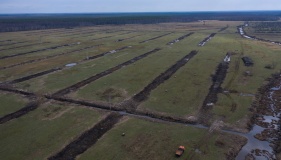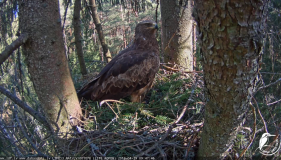On January 31 this year, the Riga Courthouse of the Administrative District Court granted the Latvian Fund for Nature's (LDF) application to declare illegal the decision of the State Forest Service (VMD), which annulled VMD regional superintendent's decision to establish a micro-reserve for the lesser spotted eagle. This was one of three essentially similar lawsuits brought by LDF in recent years against the VMD's decisions annulling VMD's own decisions to establish micro-reserves.
‘The Court's decisions clearly indicate that nature protection is a legal obligation in the name of the public interest,’ admits Jānis Ķuze, LDF expert and representative in court proceedings.
Taken together, these three lawsuits highlight the complex issues surrounding the question of micro-reserves in Latvia, point to significant systemic weaknesses in our nature conservation management, and encourage discussion of the balance between public and individual interests and our rights and responsibilities when it comes to nature protection.
Therefore, we will briefly present the course of the three court proceedings, the views of the parties involved and the Court's arguments regarding the establishment of micro-reserves for protected birds.
Case A
In June 2017, experts from the Latvian Fund for Nature (LDF) found a lesser spotted eagle's nest in a private forest in North Vidzeme and proposed the establishment of a micro-reserve in the territory of 6.6 ha, determining a buffer zone in the territory of 29.48 ha. In March, the application for the micro-reserve was submitted for review and decision to the VMD North Vidzeme Forestry, and it established the micro-reserve in the proposed area. Following the decision, the forest owner challenged it with the VMD Director General, and in May 2018, the VDM Director General annulled the original decision. This was based on the argument that the lesser spotted eagle population in Latvia is currently stable and it is not an endangered bird, there are already 264 micro-reserves established for lesser spotted eagles in Latvia, and the impact of economic activity in this area will not be critical to the lesser spotted eagle habitat. VMD recommended that the protection of the nest be ensured by maintaining a row of trees around the nest, and as one of the counter-arguments for creating a micro-reserve was mentioned the negative attitude of the owner.
LDF Claim
The Latvian Fund for Nature (LDF) did not agree with this argument and appealed to the Administrative Court to annul the decision and to renew the original decision. LDF argued that VMD had no reason to question the need for protection of the lesser spotted eagle and the suitability of the micro-reserve as a tool for the protection of the species. The legislator has unequivocally recognized the lesser spotted eagle as a specially protected bird species, and although the population of the species is stable, there have been periods in Latvia when the number of these birds has decreased, and Latvia is a nuclear area where it is especially important to ensure adequate protection. LDF also emphasized that the protection of lesser spotted eagles is particularly important in private forests, as only about a third of all lesser spotted eagles nest in public forests. Due to the ecological peculiarities of the lesser spotted eagle, the preservation of a row of trees proposed by VMD is not a solution for nest protection, as only 3% of pairs nest in trees left in felling areas and in small groups of trees. The only way to ensure protection is to restrict economic activity in the nesting area, which in Latvia can currently be achieved only by creating micro-reserves. LDF also recalled the legitimate aim of establishing the micro-reserve – protection of the environment in the interests of public. In addition, this micro-reserve is proposed for a small area – only 6.6 ha, while the maximum area can be 30 ha. It is important to add that LDF's arguments were also supported by the Nature Protection Board, which is the state institution responsible for nature protection in Latvia.
VMD Explanation
VMD further clarified the case stating, inter alia, that micro-reserves are not the only way to ensure the conservation status of a species, and emphasized that micro-reserves should be established as a matter of priority in public forests, and in private ones only if the owners do not object. VMD also explained that they had assessed the principle of proportionality and concluded that the infringement of private law by creating a single micro-reserve was not justified. The forest owner, who had been summoned to court as a third party, stated in his explanation that the lesser spotted eagle had not been seen on the property and, like VMD, claimed that the principle of proportionality had not been taken into account.
Discussion
There are several lines of discussion in this process. One of them is the question of VMD discretion and competence – whether this state institution, which is subordinated to the Ministry of Agriculture, is entitled to interpret the provisions of Latvian nature protection laws and regulations and decide which species are specially protected and which do not need to be protected. This position was evidenced both by the abolition of micro-reserve by VMD and by arguments in Court. In the opinion of LDF, VMD acted outside their competence, and not only – such a position of VMD indicates a danger to the nature protection system as a whole, as VMD violate their powers and do not assess the need for a micro-reserve for natural, social and economic reasons, but indicate that establishment of micro-reserves is almost voluntary.
Judgement of the Court
What was the Court's decision in this case? In assessing whether the interests of nature protection or the economic interests of the forest owner take precedence, the Court took into account that the lesser spotted eagle is included in the list of specially protected bird species in Latvia and in the list of the EU Directive on the Conservation of Wild Birds as a species subject to habitat protection measures. It is therefore clear that the lesser spotted eagle is a species that needs special protection.
If VMD did not dispute this statement in their reasoning, they strongly questioned the effectiveness and validity of the micro-reserve as a nature conservation tool, and repeatedly emphasized that the stability of the lesser spotted eagle population could justify not establishing new micro-reserves, but existing nests could be protected in other ways.
However, the Court stated that the establishment of a micro-reserve is the most effective way to protect the lesser spotted eagle's nesting site, as it provides protection not only for the nest tree and its surroundings, but also for the wider environment required for the lesser spotted eagle.
Nor did the Court find a disproportionate violation of the interests of the third party – the micro-reserve has not been established in the entire property and the performance of economic activity in the buffer zone is permitted.
Consequently, the Court granted LDF's application and upheld the original decision of VMD imposing the micro-reserve. VMD have appealed against the decision of the Administrative District Court.
Case B
The second case is similar to the one already described. In August 2017, an LDF expert found a lesser spotted eagle's nest in a private forest in North Kurzeme, an application for a micro-reserve was submitted to the VMD North Kurzeme Forestry and it decided to establish a micro-reserve in the area of 5.87 hectares. Once again, the forest owner challenged the decision of VMD, and on June 18, 2018 VMD revoked the initial decision to establish a micro-reserve. LDF challenged this decision in the Administrative District Court.
As in the previous case, both VMD and the third-party forest owner explained that they did not question the need for protection of the lesser spotted eagle, but considered that the micro-reserve was only an additional means of protection that could be introduced, but not mandatory. The forest owner emphasized that the interests of nature protection have been observed, even without creating a micro-reserve.
In this case, too, VMD continued to maintain their claim that the threat and need for protection of the lesser spotted eagle was not substantiated and that micro-reserve should only be imposed if the owner did not object.
In their explanation, LDF reminded the Court that the protection of the lesser spotted eagle is a mandatory obligation under national and European Union law and that there is no mechanism of protection other than a micro-reserve.
Examining the peculiarities of the species, the need for protection and other possible solutions, the Court concluded that the establishment of a micro-reserve is the optimal form of protection. Also, in the opinion of the Court, the opinion of forest owners can be heard, but it cannot have a decisive influence on the decision-making.
Examining the circumstances of the case in connection with the legal norms, the Court also granted this application of LDF and ordered VMD to issue an administrative act, which would establish a micro-reserve. VMD have appealed against this Court decision, too.
Case C
The third case is similar to the two previous ones, but with one significant difference – a ‘missing’ nest and the subsequent deforestation at the place where the micro-reserve was proposed.
So, in the summer of 2017, experts found a lesser spotted eagle's nest in a private forest in Central Vidzeme. In December 2017, LDF submitted an application for the establishment of a micro-reserve, and in April 2018, the Central Vidzeme Forestry decided to establish a micro-reserve in 6.54 hectares of forest. The company that owned the forest challenged this decision, and in June 2018 VMD revoked it, stating that the nest has ‘disappeared’ from the site and that it is necessary to balance the interests of the public and the forest owners. LDF applied to the Court to restore the original decision and to establish a micro-reserve – the ‘disappearance’ of the nest cannot be a reason not to establish a micro-reserve in the nesting area where the presence of the lesser spotted eagle has been established. Signs in nature indicated that the nest might have been deliberately felled, as there were traces of climbing on the bark of the tree, and the nest was in a very stable jaw, in such situations the nests do not tend to fall suddenly. The fact that VMD accepts the practice that the 'disappearance' of a nest is a legitimate reason for not establishing a micro-reserve sets a dangerous precedent and a risk that could lead to further destructions of the nests.
During the court proceedings, the owners of the forest where the micro-reserve was established changed several times, and one of the new owners cut down the forest stand. Consequently, LDF's original claim – to restore the micro-reserve – became meaningless, as the lesser spotted eagle's habitat had already been destroyed, so the claim was changed – the foundation asked for VMD's decision to be declared illegal. The Court granted this request. According to the Court's judgement, the fact that the disappearance or fall of a nest could justify the non-establishment of a micro-reserve may have negative consequences for the further protection of lesser spotted eagles, as it may encourage property owners to take illegal action to facilitate the 'disappearance' of nests.
Issues Highlighted in Court Proceedings
It should be noted that the discussions during the court proceedings highlighted a number of issues that could also be relevant to the general public, especially those directly affected by nature protection measures.
One of these issues is the conservation status of the lesser spotted eagle. The status of a specially protected species for this bird is determined by both Latvian and EU laws, but it is often confused why we should especially protect a bird that, according to all evidence, feels good in Latvia – one-fifth of the world's population nests here, about 4,000 couples, and the number of nesting couples is currently stable. However, this issue needs to be looked at more broadly in time and space – if population dynamics are stable at present, this does not mean that it is so in the long run. Thus, twenty years ago, the number of lesser spotted eagles in Latvia decreased, and the current situation in Latvia's forests and the intensification of agriculture make it reasonable to predict that the situation with nesting and feeding areas for lesser spotted eagles could worsen. Another important aspect – Latvia is the centre of the lesser spotted eagle population in Europe, and the most important task is to protect the protected species in its most important nesting places, because in this way it is possible to ensure the sustainability of the species as a whole.
The second issue that is worth considering in essence is the mandatory introduction of micro-reserves as a nature protection instrument. The Law on the Protection of Species and Habitats states that ‘a micro-reserve may be established’, and this phrase is often interpreted as an option to choose whether or not to establish it. However, in the context of the need for species protection and the protection instruments available in Latvia, it is clear that the micro-reserve is currently the only effective protection instrument for diffusely nesting protected birds. Can the status as a site of the Natura2000 network of protected nature areas replace the micro-reserve? No, as logging may also be allowed in Natura2000 sites, depending on the protection zone. For example, in Kuja Nature Park, which is included in the Natura2000 network and in which historically the highest density of lesser spotted eagles has been found, a large number of micro-reserves have been established in the eagles’ nesting places after the establishment of the nature park. In the Court's view, the wording of the law 'a micro-reserve may be established' does indicate that a literal interpretation also allows them not to be defined, but these exceptions may exist, for example, where the site already enjoys protection as a special nature reserve.
The next big question that these lawsuits raise is the competence, responsibility and capacity of VMD. The Court has already stated that the need for the protection of a species must be assessed in accordance with the law and not with the opinion of a single authority, which is not based on the opinions of certified species experts. It is important to emphasize that LDF in cooperation with VMD have also had a positive experience, balanced decision-making and a reasonable search for a compromise if the owner objects to the establishment of a micro-reserve. It would be important for VMD to define more clearly the system and criteria according to which they evaluate the social and economic factors when evaluating proposals for the establishment of micro-reserves – there are currently no clear criteria in this regard.
Also, a very important finding, which was also confirmed by the Court in these proceedings, is that the attitude of forest owners cannot be decisive when deciding on the establishment of a micro-reserve. If we adhered to such a principle, then the existence of the nature protection system in Latvia as a whole would be endangered. That is why it is very important that there is a competent and responsible institution that comprehensively assesses social, natural and economic factors.
The Court acknowledged that insufficient compensation to forest owners for restricting economic activity is a problem, but cannot be considered in the context of these court proceedings. LDF has been urging the responsible authorities to improve the compensation system for a long time – a working group is currently being set up under the auspices of the Ministry of Environmental Protection and Regional Development to work on this issue, which is a small but still a step forward. The need to improve the compensation system and ensure adequate compensation is an issue on which the forest-based industry and environmental organizations agree, and we hope that solutions will be found.
And finally, the most significant problem highlighted by the third case points to a fundamental systemic shortcoming in Latvia's nature protection. In Latvia, prior to logging, no assessment of natural values in the forest is performed, only an inventory of the economic value of the forest. If such an arrangement existed, the destruction of natural values would be prevented, forest owners would not arrive at a position of an offender and would gain a broader view of what their forest wealth is.







